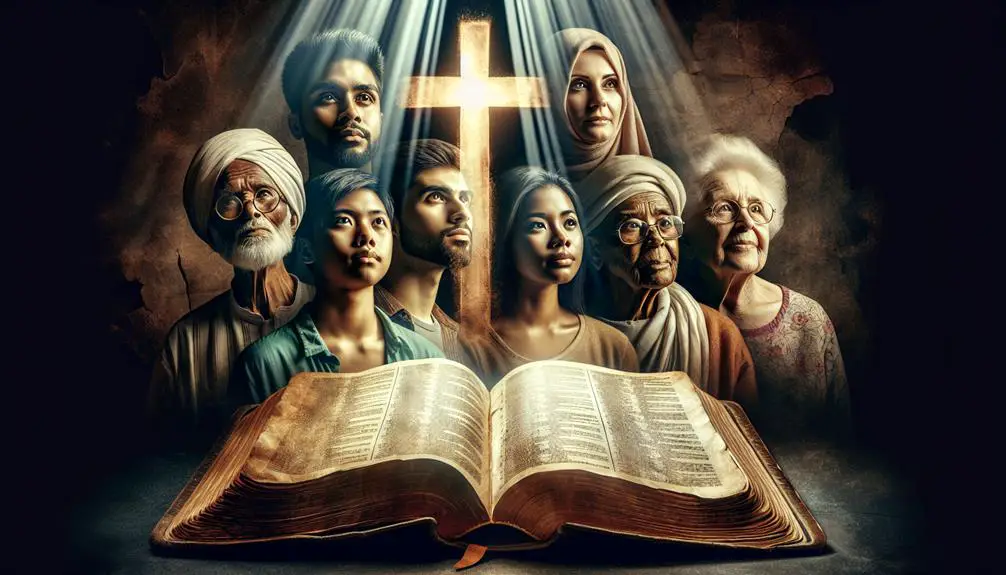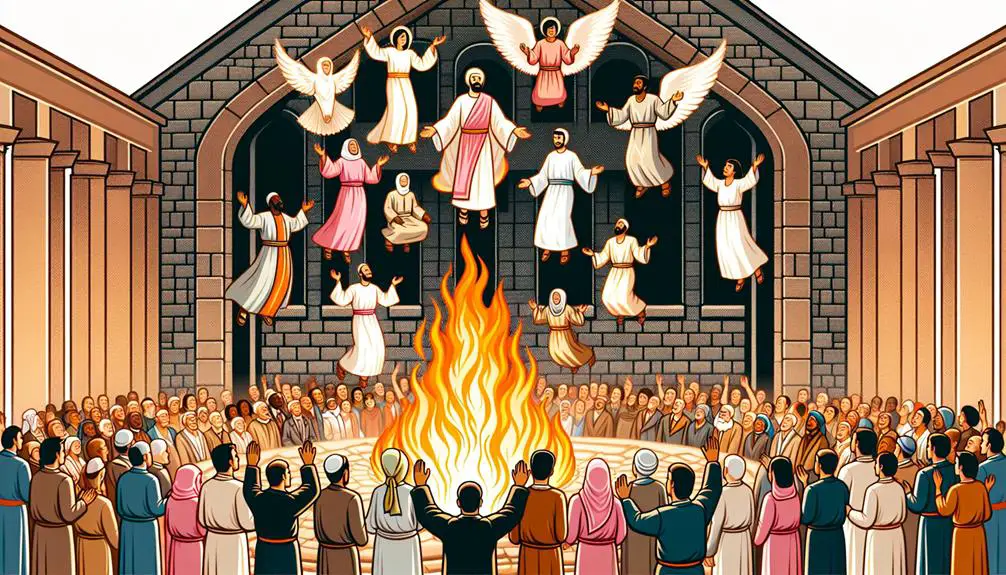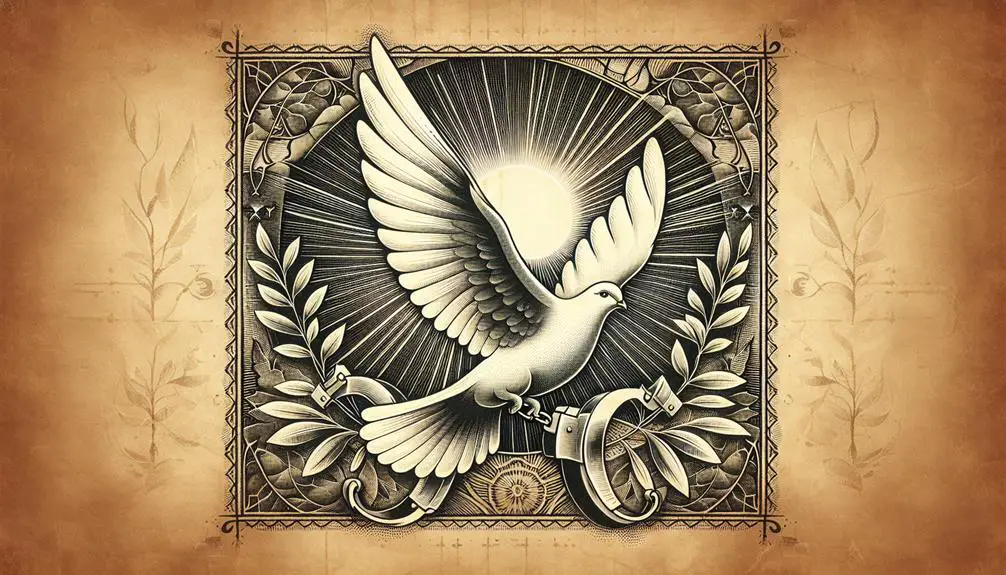Discover the profound symbolism of the number 50 in the Bible, hinting at freedom and new beginnings.

50 Meaning in the Bible
Did you know that the number 50 appears 154 times in the Bible, each instance carrying its own unique significance?
This number symbolizes freedom, liberation, and the promise of new beginnings, echoing through events such as the Jubilee Year and the day of Pentecost.
As you explore the depths of its biblical importance, you'll uncover how the concept of 50 weaves through themes of restoration, prophecy, and divine intervention.
What's fascinating is how this number has influenced both historical and spiritual narratives, hinting at a broader, more intricate tapestry of meaning that awaits your further exploration.
Key Takeaways
- The number 50 symbolizes freedom, liberation, and new beginnings in biblical context.
- It is associated with the Jubilee Year, emphasizing economic and social justice through debt cancellation and land restoration.
- Pentecost, occurring 50 days after Easter, represents spiritual transformation and the empowerment of disciples through the Holy Spirit.
- The principles around the number 50 advocate for human dignity, equitable access to resources, and community renewal.
The Jubilee Year

Delving into the concept of the Jubilee Year, it's crucial to understand its profound significance as a cornerstone of economic and social justice within biblical tradition. This concept isn't merely a historical footnote; rather, it's a radical vision for societal equity and harmony. The Jubilee Year, as outlined in the Hebrew Bible, mandated the periodic return of all alienated land to its original family owners and the cancellation of all debts every 50th year. This cycle served as a powerful counterbalance to the accumulation of wealth and the entrenchment of inequality.
Land redistribution played a pivotal role in this system. It ensured that the inevitable economic disparities that developed over generations were periodically corrected, preventing the permanent stratification of society into rich and poor. This mechanism allowed families who'd fallen into poverty and sold their land as a last resort, the opportunity to start afresh, free from the shackles of perpetual debt and landlessness.
Debt cancellation, equally critical, released individuals from the burden of unpayable debts, which in ancient times could result in enslavement or severe social marginalization. By wiping the slate clean every Jubilee, society was reminded of the importance of compassion and the inherent dignity of every person, irrespective of their economic status.
The Jubilee Year's principles challenge you to rethink contemporary approaches to economic disparities and social injustices. They offer a blueprint for a society that prioritizes human dignity, equitable access to resources, and the cyclical renewal of community bonds over the relentless accumulation of wealth and power.
Pentecost Significance

While the Jubilee Year offers a framework for economic and social restoration, Pentecost holds a distinct significance in fostering spiritual renewal and empowerment within the biblical narrative. This pivotal event, marked by the descent of the Holy Spirit as tongues of fire upon the disciples, symbolizes a moment of profound transformation not only for the followers of Jesus but for the entire course of Christian mission and understanding.
Pentecost stands out as a moment where barriers are transcended, bringing forth a new era of understanding and communication among diverse peoples. The manifestation of the Holy Spirit enabling the disciples to speak in various languages embodies the essence of a multicultural gathering, breaking down the walls that had previously divided nations and communities. This miraculous event underscores the inclusive nature of the Christian message, emphasizing that it's intended for all, regardless of linguistic or cultural background.
Furthermore, the imagery of tongues of fire signifies purification and dedication. It's as if the disciples are being anointed anew, equipped with spiritual gifts that empower them to preach, heal, and perform miracles. This empowerment isn't just for personal edification but is fundamentally about equipping them for service, to spread the teachings of Jesus with renewed vigor and authority.
In this light, Pentecost isn't merely a historical event; it's a theological cornerstone that highlights the transformative power of the Holy Spirit. It marks the birth of the Church as a dynamic, spiritual entity, driven not by human might but by the profound and moving presence of God's Spirit. It's a celebration of unity, diversity, and the unbounded potential of spiritual empowerment.
Freedom and Liberation

In the biblical context, freedom and liberation aren't merely political or social concepts but embody profound spiritual and existential dimensions that resonate with individual and collective experiences. You'll find that the Bible intricately weaves slavery narratives with overarching themes of liberation, serving not as mere historical accounts but as profound illustrations of God's desire for human freedom from bondage, both physical and spiritual.
The Exodus story, for instance, isn't just an ancient tale of liberation; it's a foundational narrative that has inspired countless individuals and communities across ages to seek their own freedom. This story, with its dramatic escape from Pharaoh's clutches, showcases a God deeply invested in the liberation of His people. It sets a precedent, illustrating that freedom is an inherent, God-given right.
Drawing parallels from the Exodus, you can observe similar themes of liberation in the prophetic books, where prophets speak against injustices that lead to spiritual or physical enslavement. These narratives encourage a deeper understanding of freedom, not as an end but as a journey towards fulfilling one's purpose under God's guidance.
Moreover, the New Testament continues this theme, where Jesus' teachings and actions consistently point towards liberating the oppressed, breaking societal chains, and offering a new kind of freedom that transcends physical states. In essence, the Bible's exploration of freedom and liberation challenges you to reflect on your own experiences of bondage and liberation, urging a journey towards spiritual freedom that aligns with divine will.
Holy Spirit Descent

The descent of the Holy Spirit, as recounted in the Acts of the Apostles, marks a pivotal moment in Christian theology, symbolizing the empowerment and indwelling of God's presence within believers. This event, characterized by the appearance of tongues of fire and the sound of a mighty wind, signifies the fulfillment of Jesus' promise to send an advocate or helper after his ascension.
Dove imagery, deeply embedded in this narrative, serves as a bridge connecting the Holy Spirit's descent to the concept of peace, purity, and divine approval. You'll recall the dove's appearance during Jesus' baptism, an event that prefigures this descent. This connection isn't coincidental but rather a deliberate theological statement underscoring the continuity of God's salvific plan from Jesus' ministry to the empowering of the early church.
The baptism connection reinforces this link, highlighting the transformative power of the Holy Spirit. Just as baptism represents a believer's initiation into the Christian faith, the descent of the Holy Spirit marks the birth of the church and the beginning of its global mission. This event encapsulates the transition from the physical presence of Jesus among his followers to his spiritual presence through the Holy Spirit, guiding, empowering, and sanctifying the believers.
Through this lens, you can appreciate the descent of the Holy Spirit not merely as a historical event but as a profound theological reality that continues to influence Christian thought. It affirms the belief in God's ongoing presence in the world and among His people, ensuring that the message of Jesus Christ transcends time and space.
Offerings and Sacrifices

As you explore the subtopic of 'Offerings and Sacrifices' in the Bible, it's crucial to understand the various types of biblical offerings and their distinct purposes. These practices weren't mere rituals but were deeply embedded in the fabric of ancient religious life, serving as a bridge between the divine and the human.
Analyzing the rituals and procedures surrounding these offerings reveals the complex interplay of faith, obedience, and atonement in the biblical narrative.
Types of Biblical Offerings
Exploring the types of biblical offerings reveals a complex system of sacrificial practices central to ancient worship and societal norms. You encounter a diversity of offering materials and sacrificial animals, each with its specific significance and rules.
Grain, oil, and wine often served as non-blood offerings, symbolizing the sustenance of life and gratitude towards divine provision. In contrast, sacrificial animals, including lambs, goats, and pigeons, were integral for atonement and ceremonial purification. These offerings varied from voluntary expressions of devotion to mandatory rites for community reconciliation.
Understanding this intricate framework allows you to grasp the multifaceted nature of ancient religious observance, where material offerings and sacrificial practices intertwined with spiritual and communal life.
Purpose of Sacrifices
Building on the understanding of various biblical offerings, it's crucial to examine their intended purposes, which were deeply rooted in spiritual, communal, and moral dimensions. These sacrifices, especially animal atonement, played a pivotal role within the cultural context of ancient societies. They served not just as rituals but as profound expressions of faith, repentance, and dedication.
Purpose |
Description |
|---|---|
Spiritual Reconciliation |
Animal atonement bridged the gap between the divine and humanity. |
Communal Solidarity |
Offerings fostered a sense of unity and shared responsibility. |
Moral Reflection |
Sacrifices prompted introspection and commitment to moral living. |
Rituals and Procedures
Delving into the rituals and procedures of offerings and sacrifices reveals a complex system of religious practices that shaped the spiritual landscape of ancient communities. These procedures weren't merely physical acts but deeply symbolic gestures that intertwined with the fabric of societal and spiritual life, emphasizing a connection between the community, its members, and the divine.
Ceremonial cleansings were pivotal, ensuring participants were purified before engaging in sacred acts.
Offerings varied, including animals, grains, and incense, each bearing specific symbolic meanings.
Temple duties were rigorously defined, with priests playing key roles in the execution of these rituals.
Specific prayers and chants accompanied each offering, enhancing the spiritual ambiance.
The intent behind sacrifices ranged from atonement to thanksgiving, reflecting a wide spectrum of human emotions and divine expectations.
Restoration Themes

You'll find that restoration themes in the Bible, particularly through the Jubilee Year symbolism and the renewal of the covenant, encapsulate a profound narrative of redemption and rebirth.
These elements underscore humanity's enduring relationship with divinity, marked by cycles of renewal and opportunities for a fresh start.
The intricate interplay between these themes offers a rich tapestry for understanding the deeper meanings embedded within biblical texts.
Jubilee Year Symbolism
In the biblical context, the Jubilee Year stands as a profound symbol of restoration and renewal, embodying themes of freedom, debt forgiveness, and the return of land to its original owners. This unique time wasn't only about physical and economic restoration but also held deep spiritual significance, underscoring the importance of:
- Debt cancellation: Liberating individuals from the burden of debts.
- Land restoration: Ensuring land reverted back to its original family lineage.
- Emancipation: Freeing slaves and allowing them to return to their families.
- Social equality: Leveling societal hierarchies by redistributing wealth and opportunities.
- Spiritual renewal: Encouraging a collective return to ethical and religious practices.
Analyzing the Jubilee Year reveals a holistic approach to societal justice and harmony, emphasizing the interconnectedness of economic actions and spiritual well-being.
Renewal of Covenant
The theme of covenant renewal in the Bible showcases God's commitment to restoring broken relationships and reaffirming His promises to His people. This principle is deeply rooted in covenant theology, emphasizing that faithfulness rewards with a restoration of divine favor and fellowship.
Theme |
Significance |
|---|---|
Restoration |
Highlights the renewal of relationships and promises between God and humanity. |
Faithfulness |
Demonstrates that steadfastness in covenant obligations leads to divine rewards. |
Divine Promise |
Reaffirms God's unchanging commitment to His people. |
Community Rebuilding |
Focuses on the communal aspect of covenant renewal, fostering unity and peace. |
Future Hope |
Points to the ultimate fulfillment of God's promises in a perfected world. |
This approach underlines the cyclical nature of renewal, where lapses in faithfulness are met with opportunities for restoration and a deeper understanding of divine grace.
Prophetic Symbolism

Prophetic symbolism permeates the Bible, offering profound insights into its narratives and teachings. As you delve into the scriptural texts, you'll find that symbols serve not merely as decorative elements but as keys unlocking deeper meanings and divine messages. Particularly, dream interpretations and angelic encounters play pivotal roles, guiding prophets and kings, shaping destinies, and revealing God's will.
Consider these aspects of prophetic symbolism to deepen your understanding:
- Dream Interpretations: Biblical dreams are laden with symbols that, once interpreted, reveal messages from the divine. Joseph's ability to interpret dreams in Egypt showcases how such symbols foretold future abundance and famine, influencing the course of history and salvation.
- Angelic Encounters: Angels often appear as messengers bearing symbolic significance. Their presence alone can signify divine intervention, protection, or the announcement of pivotal events, as seen in the visions of Daniel and the Annunciation to Mary.
- Water: Frequently symbolizes purification and life-giving force but can also represent chaos and destruction, as in the story of Noah's flood or the parting of the Red Sea.
- Light and Darkness: Serve as metaphors for knowledge, presence of God (light), and ignorance or absence of divine presence (darkness). This dichotomy is central to understanding the moral and spiritual battles depicted in the scriptures.
- Numbers: Carry symbolic meanings, with numbers like 7, 12, and 40 often representing completeness, divine order, or periods of testing and judgment.
Historical Events

Many historical events detailed in the Bible not only shaped the ancient world but also carry profound symbolic meanings that continue to resonate with readers today. Consider the Battle of Jericho, a narrative rich in symbolic gestures of faith and the power of divine intervention. You're invited to delve into the story, where the walls of Jericho fell after the Israelites circled them for seven days, blowing trumpets. This wasn't merely a military conquest; it symbolized the triumph of faith over formidable obstacles. The walls represent barriers in your life that seem insurmountable, but with faith, can be overcome.
Similarly, King David's reign isn't just an account of political and military leadership. It's a tapestry of moral lessons, personal failings, and divine grace. David's life, from his humble beginnings as a shepherd boy to becoming the king of Israel, teaches you about the importance of humility, the consequences of one's actions, and the possibility of redemption. His reign, marked by both wisdom and failure, illustrates the complexity of human nature and the potential for forgiveness and restoration.
These historical events, emblematic of deeper truths, beckon you to reflect on your own life's challenges and victories. They encourage you to see beyond the literal to the symbolic, where faith can topple walls, and personal failings can be the soil for growth and redemption. Thus, the Bible's historical narratives serve not only as records of the past but as enduring sources of inspiration and insight for the present.
Frequently Asked Questions
How Does the Concept of Love Manifest in Different Relationships According to the Bible, Beyond the Contexts of Freedom, Sacrifice, and Prophecy?
You'll find that love shapes relationships through parental guidance and brotherly kindness, extending beyond freedom, sacrifice, and prophecy.
These concepts aren't just abstract; they're practical, affecting how individuals interact daily. Parental guidance reflects love's nurturing aspect, teaching and leading by example. Brotherly kindness showcases love's unifying force among peers, promoting empathy and support.
Together, they illustrate love's multifaceted role in fostering strong, compassionate relationships.
In What Ways Does the Bible Address the Issue of Personal Identity and Self-Worth Outside the Narratives of Liberation and Restoration?
'As you sow, so shall you reap.' The Bible intricately addresses personal identity and self-worth by emphasizing that you're made in the Image of God, underscoring your inherent value and dignity.
It also highlights the concept of Spiritual Gifts, suggesting that your unique talents aren't just for personal fulfillment but serve a higher purpose.
This perspective offers a profound understanding of self-worth, rooted in divine origin and purpose, beyond mere human accomplishments.
How Does the Bible Guide the Understanding of Mental Health and Coping With Anxiety or Depression, Separate From the Holy Spirit's Descent and Prophetic Symbolism?
You'll find that guidance on mental health, specifically coping with anxiety or depression, emphasizes prayerful healing and mindful meditation.
These approaches advocate for a deep, personal engagement with one's inner self and emotions. Through prayerful healing, you're encouraged to seek solace and understanding, whereas mindful meditation offers a method to center your thoughts, fostering a calm and focused mind.
Both practices are valuable tools for navigating mental health challenges.
What Does the Bible Say About the Stewardship of the Environment and Animals, Not Directly Related to Offerings, Sacrifices, or Historical Events?
You might wonder how your actions impact the world around you. It's not just about reducing your carbon footprint or recycling.
Delving into Creation Care and Animal Compassion reveals a deeper layer. These concepts, rooted in respect and responsibility, challenge us to consider our role in the environment and towards animals.
Analyzing these principles offers a profound insight into sustainable living, emphasizing our duty to nurture and protect, not just consume and exploit.
How Are Concepts of Time and Eternity Explained in the Bible, Apart From the Specific Teachings on the Jubilee Year and Pentecost Significance?
You're delving into how concepts of time and eternity are understood, setting aside jubilee and Pentecost.
The Bible presents time not just linearly but as part of a grand, divine narrative, culminating in the Eternal Sabbath. This represents a timeless wisdom, emphasizing an eternal perspective over our transient existence.
Conclusion
In essence, the number 50 weaves a tapestry of liberation and renewal within the biblical narrative. Like the rejuvenating cycle of the Jubilee, it symbolizes a divine reset—a chance to realign with spiritual and communal harmony.
At its core, this number heralds the descent of the Holy Spirit at Pentecost, infusing the faithful with a transformative power. It's a poignant reminder that in the realm of faith, liberation and restoration are perpetually within grasp, echoing through the ages as a testament to divine grace and providence.



Sign up